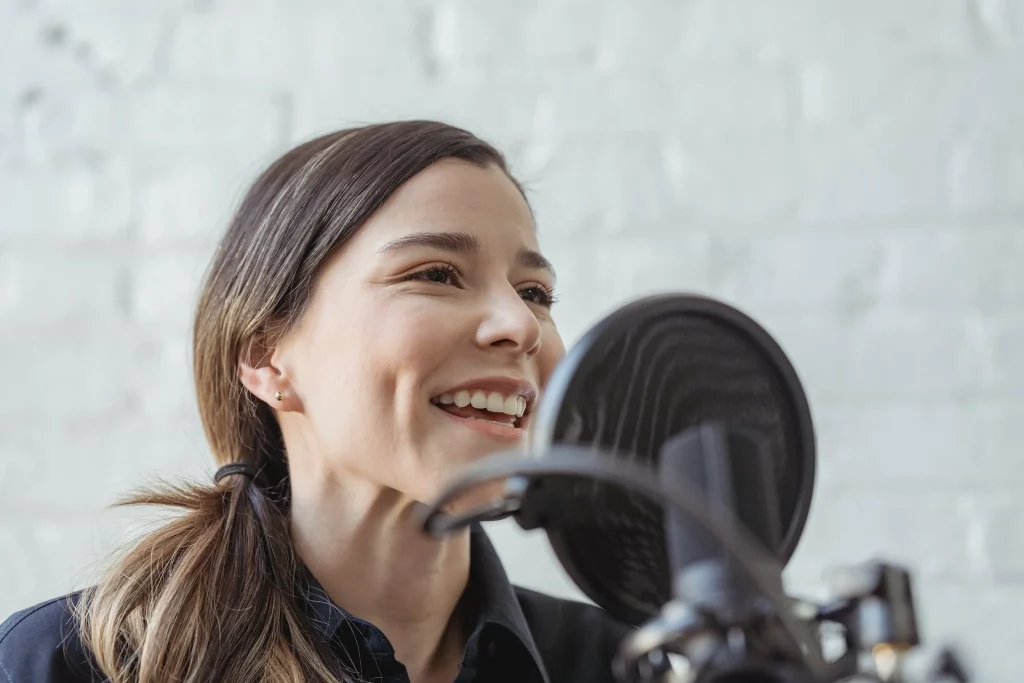Podcasters, gather ’round! Whether you’re a seasoned podcaster or just starting to dip your toes into the vast ocean of podcasting, sound quality matters. After all, who wants to listen to a podcast that sounds like it was recorded in a tin can? Podcast sound quality can really make or break a show!
So, to keep your audience’s ears happy, here are ten essential tips to improve your podcast’s sound quality.
1. The Magic Wand: A Good Quality Microphone
Imagine trying to paint the Mona Lisa with a dollar store paintbrush. Not an ideal situation, right? The same principle applies to your microphone during the recording process. You need the right tool for the job.
While USB microphones are the budget-friendly option, stepping up to an XLR microphone is like going from a tricycle to a Ferrari. The sound difference is noticeable, and your listeners will thank you!
2. Pop Goes the Weasel: Using a Pop Filter
Remember when you were a kid and would try to scare your friends by popping a balloon behind their back? That’s the audio equivalent of what happens when you pronounce ‘P’ and ‘B’ sounds without a pop filter in front of your microphone.
A pop filter is your podcast’s knight in shining armor, defending it against those pesky plosive sounds.

3. Setting the Stage: Optimize Your Recording Environment
Would you run a marathon in flip flops? Probably not. So why record a podcast in an echoey room? Soft surfaces are your best friend when it comes to audio recording. So, this should be your basis when choosing a recording space.
Think of it like this: your voice is Tarzan, and soft surfaces like carpeted floors or foam panels are the vines it swings on. They help absorb sound and prevent it from bouncing around like a hyperactive squirrel.
4. Close but Not Too Close: Consistent Distance from the Microphone
Getting too close to the microphone is like eating a pizza slice with extra garlic before a date. It’s just not a good idea. A two-inch distance from the microphone is your sweet spot. This helps to ensure that your podcast doesn’t have more ups and downs than a roller coaster ride when it comes to sound levels.
To have better sound quality, you can use a mic stand so the distance is fixed.

5. Hear Every Detail: Use High-Quality Headphones
Using high-quality closed-back headphones to monitor your recording is like having a magnifying glass for your ears. They help you catch those sneaky little sounds that might be playing hide and seek with your podcast audio quality. And don’t forget to regularly review your audio files!
6. Your Audio Magic Toolbox: Leverage Audio Editing Software
Audio editing software is like the Mary Poppins bag of podcasting. It’s full of tools that can transform your podcast from sounding like a novice karaoke night to a polished studio recording.
Audacity, Adobe Audition, or GarageBand can help you banish background noise, balance audio levels, and make your podcast sound as smooth as a jazz saxophone solo.
7. Be an Audio Wizard: Learn Basic Audio Production Skills
Knowledge is power, especially when it comes to quality audio production. Understanding the basics of audio editing, mixing, and mastering is like getting the cheat codes to your favorite video game. It can help you level up your podcast’s sound quality faster than you can say “subscribe.”

8. Play Around: Experiment with Microphone Techniques
Ever tried to find the best angle for a selfie? Well, finding the right technique for speaking into your microphone isn’t much different.
Sometimes, speaking directly into the microphone gives you that rich, full-bodied sound. Other times, speaking off-axis could be your secret weapon against unwanted noises. So, don’t be afraid to experiment to find the best audio quality!
9. Keep It Clean: Regularly Maintain Your Equipment
Just like you wouldn’t let your car run without an oil change, don’t neglect the regular maintenance of your podcast equipment. A clean microphone, well-checked cables, and up-to-date software can drastically improve podcast sound quality.
10. The Rehearsal: Always Record a Sample
Before you step onto the stage of podcasting, always record a sample. It’s like your dress rehearsal before the big show. This gives you a chance to catch any potential sound gremlins and kick them to the curb before you hit the record button for your main podcast. Think of it almost like you’re recording music!

Why Great Podcast Sound is Absolutely Essential
Imagine you’re at a symphony. The orchestra tunes their instruments, the conductor raises the baton, and with one swift movement, a beautiful melody fills the air.
But wait, there’s a problem. The sound system is terrible, turning Mozart into a static-filled mess. Suddenly, the symphony isn’t so wonderful, is it? This is the same scenario when it comes to podcasting.
Great sound isn’t just a nice-to-have for your podcast; it’s a must-have. It’s the secret ingredient in your podcasting recipe that can turn your show from “meh” to “wow.” Let’s take a quick journey down the yellow brick road of podcasting to discover why.

The Invisible Stage
In the land of podcasts, your voice is your face. It’s the primary tool you have to connect with your listeners.
You don’t have flashy visuals, stunning graphics, or eye-catching designs to rely on. It’s just you, your voice, and the listener’s imagination.
If you have poor audio quality, it’s like trying to perform a Shakespearean play with all the actors wearing clown masks. It distracts from the content, dilutes your message, and can make your podcast a chore to listen to, rather than a pleasure.
The Bond of Trust
When you’re podcasting, you’re not just sharing information or telling stories. You’re building a relationship with your listeners. And like any good relationship, trust is key.
If your podcast sounds like it was recorded during a hurricane, or if your voice fluctuates between whisper-quiet and ear-shatteringly loud, it can erode that trust.
It sends the message that you don’t care enough about your audience to provide them with a high-quality listening experience.

The Survival of the Fittest
Let’s face it, folks, the podcasting world is more crowded than a subway car during rush hour.
There are millions of podcasts out there, all vying for the same listeners. Having great sound quality isn’t just a way to stand out from the crowd; it’s a way to survive.
In this Darwinian landscape, podcasts with poor sound quality are like a zebra wandering into a lion’s den. They’re likely to be gobbled up and forgotten.
The Pursuit of Growth
And finally, let’s talk about growth. If you want your podcast to grow, you need to attract new listeners and keep them coming back for more.
Great sound quality is like the Pied Piper’s flute, luring listeners in and keeping them enchanted. It makes your podcast easier to listen to, more professional, and more shareable. After all, nobody wants to recommend a podcast that sounds like it was recorded in a wind tunnel.

Pitfalls to Watch Out For
Picture this: You’re Indiana Jones, and you’ve just found the golden idol of podcasting. But wait! There’s a path ahead, strewn with traps and pitfalls, ready to snatch your prize away.
The Phantom Menace: Background Noise
Ah, background noise, the Darth Vader of podcasting. It lurks in the shadows, ready to strike when you least expect it. Whether it’s the hum of your refrigerator, the chitter-chatter of people in the next room, or the relentless barking of your neighbor’s dog, background noise is a menace to your podcast’s clarity.
The Siren’s Song: Over-Editing
Editing is like salt on your favorite dish; the right amount can enhance the flavor, but too much can ruin the meal. Over-editing your podcast can strip it of its natural rhythm and tone, making it sound robotic and lifeless. It’s like turning a lively salsa dance into a rigid robot dance.
The Jekyll and Hyde: Inconsistent Sound Levels
In the world of podcasting, inconsistency is as welcome as a skunk at a garden party. Inconsistent sound levels can leave your listeners frantically adjusting their volume controls, turning a relaxing listen into an audio roller coaster ride.
Don’t be a Dr. Jekyll and Mr. Hyde with your sound levels. Consistency is key.

The Invisible Elephant: Poor Audio Equipment
Trying to record a podcast with poor audio equipment is like trying to spot an invisible elephant in the room. You might not see it, but you’ll definitely feel its impact. Your microphone is your magic wand; it can either conjure up a beautiful audio experience or turn it into a pumpkin at midnight.
The Time Traveler: Not Saving Your Work
Ever worked on a masterpiece, only to lose everything because you forgot to save? It’s like going back in time, but without the cool DeLorean ride. Not regularly saving your work is a pitfall that can cost you hours of hard work.
To Wrap Up
So there you have it, folks! Ten essential tips to improve the sound quality of your podcast. Remember, a good podcast isn’t just about what you say; it’s also about how you sound when you say it. After all, sound is the base of this type of media content. That means having great sound quality is not optional — it is a must.
Now go forth and create some ear-pleasing content!


